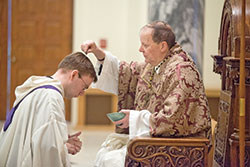Office of Worship shares guidance on Lenten liturgies during pandemic

Benedictine Archabbot Kurt Stasiak sprinkles ashes on the head of Benedictine Father Thomas Griscoski during an Ash Wednesday Mass on March 1, 2017, in the Archabbey Church of Our Lady of Einsiedeln in St. Meinrad. Since its founding in 1854, the monks of Saint Meinrad Archabbey have followed the older custom in the Church of sprinkling ashes on the top of the head on Ash Wednesday. (Photo courtesy of Saint Meinrad Archabbey)
By Sean Gallagher
Lent in 2020 was a time of loss for Hoosier Catholics.
In the dioceses of Indiana, public celebration of the Mass was suspended on March 18, 2020, just after the Third Sunday of Lent. It was a measure taken to help slow the spread of the coronavirus.
Although the pandemic continues, greater knowledge of how to protect people from it, advances in medical treatment of those infected by it and, more recently, the development of vaccines have allowed parishes for months now to welcome worshipers back to church.
“It’s a recovery of what we lost last year, the most significant celebrations of the liturgical year,” said Father Patrick Beidelman, executive director of the archdiocesan Secretariat for Worship and Evangelization.
The archdiocesan Office of Worship that he leads recently shared with parish leaders guidance regarding liturgical celebrations and public devotions related to Lent in 2021.
Many of the recommendations for Ash Wednesday, which occurs on Feb. 17 this year, penance services and the public praying of the Stations of the Cross follow practices related to social distancing and sanitizing that parishes have followed for months now during the pandemic.
“We know a lot more,” Father Beidelman said. “And we’ve been doing this for a while. So, people have become comfortable, familiar and consistent with the precautions that we should take.”
A particular precaution related to the distribution of ashes on Ash Wednesday follows a note issued by the Vatican’s Congregation for Divine Worship and the Discipline of the Sacraments, which the archdiocesan Office of Worship also shared with parishes.
The note describes sprinkling ashes on the top of a worshipper’s head during a time of pandemic.
The archdiocesan Office of Worship noted in its guidance that this practice has been the norm throughout much of Europe for centuries.
It was brought to southern Indiana in 1854 by the Benedictine monks of Einsiedeln Abbey in Switzerland who founded Saint Meinrad Archabbey in St. Meinrad. It continues in the monastic community there today.
Benedictine Brother Kim Malloy, who has served as sacristan for Saint Meinrad since 1982, spoke recently with The Criterion about the history of the practice.
“It was brought here [to Saint Meinrad] by the first monks when they came here,” Brother Kim said. “Historically, it started by ashes being put on the top of the head. Putting ashes on the forehead was a much later development.
“In the early Church, people that were excommunicated put on sackcloth and covered themselves with ashes as a penance in preparation to be received back into the community. Ashes were a symbol of penance.”
He even noted that the kind of ashes early Christians had on their bodies and the amount placed on them could blister the skin.
“It was painful,” Brother Kim said. “It wasn’t just a fashion statement.”
In reflecting on the practice for the distribution of ashes recommended by the Holy See, Father Beidelman emphasized the interior disposition that the ashes are meant to symbolize.
“Where we put the ashes as a symbol for the beginning of our time of repentance in the season of Lent isn’t as important as our interior repentance and commitment to conversion of heart,” he said. “That’s the most significant thing that we’re beginning, which is marked by this ritual gesture.”
The guidance shared by the Office of Worship also noted the deep roots of sprinkling ashes on the head found in the Old Testament, where covering the body in ashes was a sign of penance.
“What we’re doing in Lent is part of our heritage spiritually in the Judeo-Christian tradition,” Father Beidelman said.
The Office of Worship’s guidance noted that communal penance services are permitted.
“All would need to follow the same social distancing and sanitation expectations of Mass,” the guidance noted. “There may be a need for ushers to help maintain social distancing and sanitizing during the liturgy.”
Father Beidelman expects that many parishes in central and southern Indiana will forgo penance services and instead will increase opportunities for individual confession.
The public praying of the Stations of the Cross and other Lenten devotions are likewise permitted so long as “social distancing can be maintained and proper sanitizing procedures can be followed,” the guidance said.
“Much like hymnals, booklets for the Stations/devotions should not be used,” the guidance explained. “Participants could either be given booklets to keep and re-use, or disposable handouts may be used.”
(A link to “Considerations for Upcoming Liturgies and Lent 2021,” can be found at www.archindy.org/worship.) †
